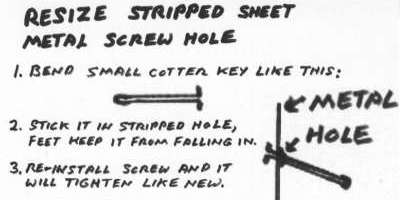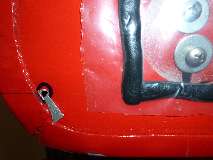The MGA With An Attitude
Repairing Stripped SELF TAPPING THREADS -- UT-105A
Self forming threads and screws come in two basic types, thread cutting screws (self-tapping) or thread forming screws (sheet metal screws). There are also thread cutting or thread forming screws for plastic materials, but there are none of those on the MGA.
For thick sections in soft metal (like a pot metal housing for instance) there are thread cutting screws that have one or more cutting flutes similar to a thread cutting tap. These threads are usually quite tight and will seldom strip out, but they might do that with repeated re-assembly. Installing a steel screw into an aluminum housing is also subject to galvanic corrosion due to electrolytic action of dissimilar metals. This can effectively weld the screw threads into the base metal part in a matter of a few years of normal existence (quicker with high humidity). Quite often the screw will break on removal, and the only resort then is to drill out the screw. For stripped threads or drilled out holes you can install a Helicoil or other threaded insert, followed by use of a straight threaded machine screw. It is highly recommended to use stainless steel screws (and anti-seize compound) for attachment to pot metal or aluminum parts to reduce the galvanic corrosion problem.
On the MGA there are a lot of sheet metal screws securing door pockets, kick panels, shut face covers, door seal end caps (all small screws), boot and bonnet prop rod clip brackets and rear kick panels (medium screws), and side curtains (larger screws). Over several decades of service the kick panels may be replaced repeatedly, and the prop rod clips and side curtain brackets are subject to heavy alternating mechanical loads and vibration. It is common for these screws to strip out the holes in the sheet metal panels. For the prop rod clips you might move the bracket over a bit and drill new holes. When installing new kick panels you might as well install new screws in slightly different locations and ignore the original holes. Side curtain brackets are less amenable to relocation, especially if you are not installing new door panels. Door seal end caps may also need to remain in the original designated location.
When you must repair a stripped hole for a sheet metal screw the standard prescription is to weld in the hole, grind it flat, and re-drill the original size smaller hole. For the larger side curtain bracket screws you might take the opportunity to weld up a thicker spot in the panel before grinding flat, thereby giving the new screws some thicker material for a stronger purchase. For small and medium size screws with low mechanical loading this works well, except that it does require access to a welder, removal of some parts, and repainting after welding and grinding.
If you can get behind the panel you might use a center punch or hammer and dolly and close the hole a bit by dinging the hole all the way around. That makes the panel thinner and weaker than original. A couple drops of solder may work if you don't mind heating the panel that much. You might otherwise install some sort of threaded insert to use straight thread machine screws.

Toggle Bolt
|

Molly Bolts
|

Rivnuts
|

Plastic Anchors
|
A toggle bolt or Molly Bolt can work if there is sufficient space behind the panel, and you don't mind a thin flange or screw head in front of the panel. Blind rivet nuts also come in a wide variety of sizes and styles. A plastic anchor as used in household drywall may work in a pinch, but these are not very strong in thin sheet metal.
For a more expedient field repair without welding it is possible to replace (or substitute) some of the original material in the stripped hole. The method you choose may relate to what materials you have handy, size of the screw, how bad the hole is stripped, and/or how much mechanical load it has to hold. You can insert a piece of stranded steel cable in the hole, install the original size screw, and trim away any excess exposed cable strands. You may similarly insert stainless wire wool or thin wood slivers (matchsticks or golf tee)
 into the hole to serve the same purpose.
into the hole to serve the same purpose.
Here's another suggestion originally supplied by John Weimer using a small split pin to fill the hole and hold the screw. This works a lot like a plastic anchor except for being much stronger.

Here's an idea from Peter Tilbury in BC, Canada. Cut a little sliver from aluminum sheet and stick it in the hole to reduce the space and give the screw a bite.
|
 into the hole to serve the same purpose.
into the hole to serve the same purpose. 



